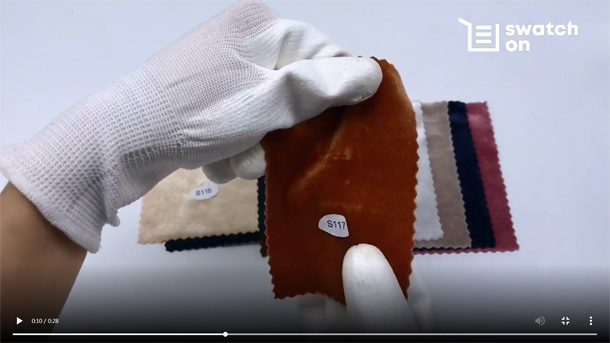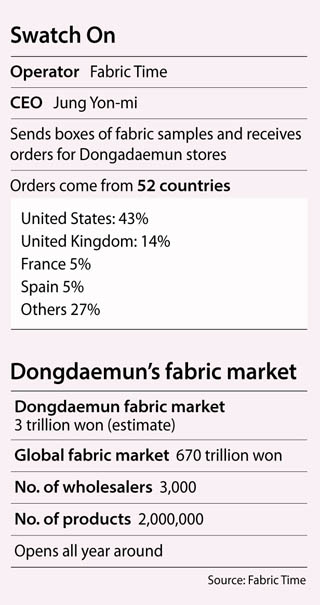Swatch On brings the world to Dongdaemun

Fabric Time CEO Jung Yon-mi [FABRIC TIME]
One practical problem a lot of these young designers face is fabric supply. Accustomed to traditional players, fabric makers put up minimum order volumes that are often unrealistic for smaller brands. There are physical restrictions, too - in Europe, fabric producers are spread out and only gather twice a year in a fabric trade show.
Local start-up Fabric Time believes the answer to their questions lies in Korea’s 50-year-old Dongdaemun fashion wholesale market in central Seoul, which is home to more than 3,000 textile manufacturers in five buildings and two billion types of fabric. The company sells the district’s products to designers around the world through its website Swatch On.
Fabric Time CEO Jung Yon-mi explained the potential demand is evident: Millennials are buying young indie brands and Dongdaemun’s fabric market has a systematic advantage.
“For young designers, the minimum order volume is a big concern, but from the seller’s side, they want to avoid holding stock and set up big thresholds to sell off large chunks at once,” said Jung.
“Dongdaemun has a very low bar because there are so many fashion wholesalers living in the same area. So we thought - why not make a database to make it easier to sell Dongdaemun fabrics abroad?”
All of Swatch On’s clients are based overseas - with United States in the lead with 43 percent, Britain at 14 percent, followed by France and Spain, both at 5 percent.
Established in September 2017, Swatch On has a vast database of fabric swatches from Dongdaemun - each entry contains a photo, detailed description of the material, fabric mixture rate and so on, and a video of the sample being stretched and squeezed. Dongdaemun’s fabric market offers a lot of these swatches for free.

A screen capture of a Swatch On video that demonstrates the texture and durability of a fabric swatch. [SCREEN CAPTURE]
Swatch On sends more than 500 swatch boxes per month to 52 countries and among them, 85 percent come back to place orders through the website. Some of the Dongdaemun fabric sold this way reached the pages of Vogue magazine and London Fashion Week.
But for the Swatch On team, accomplishing the digitalization of Dongdaemun’s fabric market turned out to be a task far more difficult than it sounds. The 50-year-old market still holds on to its old-fashioned ways: Orders are received by phone calls and vendors call out prices and the fiber mixture rate - memorized by heart - to clients visiting their stalls.

For the entirety of 2018, the Swatch On team worked to digitalize the entire process: from receiving orders and delivering them to Dongdaemun vendors via KakaoTalk to customs clearance where required documents can be automatically dispatched if products are stopped.
“Between early 2018 and this year, we reduced the time taken to process orders from seven hours to one hour and the time required on exports from one hour to 30 seconds,” Jung said.
The business took flight from January this year with monthly sales jumping 50 percent on month since then.
But despite all the time and effort taken to build the system, Jung says the response from designer clients on why they use Swatch On has never changed: “At one point, I hoped they would say it’s because the system is cool, but their response is always the good-quality fabric,” she said.
In the long run, technology advancements are under way to make use of the accumulated data and artificial intelligence. One possible scenario is enabling image searches, meaning designers will be able to look for fabric by submitting a photo from which the system will automatically suggest the most similar product in its database.
“Designers often don’t have a specific fabric in mind when they come searching on our website, so there’s been a lot of requests to recommend fabric,” said Jung. “At the moment, our staff is recommending products manually, but for AI-based personalization we need to work on enhancing accuracy and efficiency.”
BY SONG KYOUNG-SON [song.kyoungson@joongang.co.kr]










with the Korea JoongAng Daily
To write comments, please log in to one of the accounts.
Standards Board Policy (0/250자)